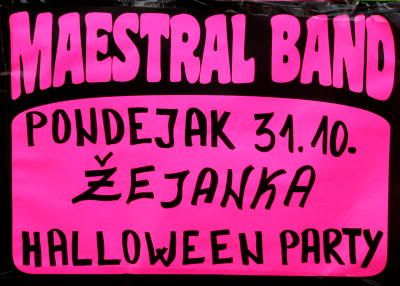"It is well-known that in north-western Croatia spectacular dialect differences are found..."

This dialect might be a surprise to you; it is quite unlike the Croatian you have seen, but it's really Croatian without any doubt — as someone said, nobody even tried to say that Čakavian is not Croatian (some other dialects were disputed, as you will learn).
What to say about this dialect? Well, archaic is the best word. I will try to demonstrate some features and give examples, but you should know that learning them is not a simple task at all (I cannot really speak it, just understand it). A poster shown on the right is one example of this dialect: word pondejak is used instead of the {ponedjëljäk} "Monday" (I'll write Standard forms in curly brackets).
The dialect is nowadays spoken in western and central Istria, north and west from Rijeka, and on the northern Adriatic island of Cres.
Sounds and Stress
The 'yat' (sequences ijë, jë, ë and ï) is almost always e. The 'yer' (ä) is always just a (except in the town of Cres and around it, where it's mostly e).
There is no sound lj in most variants, j or sometimes l is used instead: prijatel {prijatelj}, judi {ljudi}.
There are no đ and dž: j and ž are pronounced (and written) respectively.
In sequences tvr- and stv-, v is often dropped. Instead of Standard -gle-, there is -gje- (pogjedam).
The sound ć is pronounced quite differently, very "softly", like a soft t; it's a tell-tale feature of Čakavian dialects.
Instead of -m in endings, -n is always used: čitan {čitam}.
The "Final L Rule" does not work at all, there are final l's all over the place: čital {čitao}, bël "white", posäl {posäo}, etc.
There are three pitch distinctions (stress types) on a stressed vowel:
- short accent (I mark it here as à)
- long flat or rising tone (marked as ã, a "tilde" over the vowel)
- long falling tone (marked as â, a "circumflex")
The stress (one of the above three types) can be on any syllable; other, unstressed vowels can be short or long. The hard part is how to pronounce the accent marked as ã. Some local variants have lost the tone distinctions, but I will mark the "classic" stress and lengths when I am able to. Often the stress falls on the last syllable (that's impossible in the Standard Croatian: if you hear ženà, you can be almost certain you heard Čakavian). Normally the stress is not marked in writing.
Cases
The case pattern is quite different from the Standard. Locative is a special case; no case endings coincide in the plural, etc.:
case ma-nouns mi-nouns n-nouns a-nouns i-nouns nom.sg. - - -œ -a - acc.sg. -a -u dat.sg. -u -e (i) -i gen.sg. -a -i (e) -i ins.sg. -ōn -ūn -i loc.sg. -ë -i nom. pl. -i -a -e, -i -i acc. pl. -i, -e dat. pl. -on -an -in, -an gen.pl. -, -i -, -i -ih ins.pl. -i -ami -ami loc.pl. -ëh -ah -ih
There is no long plural, all nouns have only the short plural; there are no consonant changes before -i: korak "step", pl. koraki vs. Std. pl. koraci!
Many a-nouns have plural on -i. Some m-nouns have gen. pl. without any ending, some on -i, and some others on -ov.
Adjectives don't have optional endings in certain cases:, there is only one possible ending; in most variants, in all cases but the nominative, there can be only -e- in endings, regardless of the preceding sound (there is no o/e rule)! The above chart varies locally a bit, some variants are given in parentheses.
case ma mi n f nom.sg. -, -i -, -i -œ -a acc.sg. -ega -u dat.sg. -emu -oj gen.sg. -ega -e ins.sg. -in -un loc.sg. -en -oj dual (2-4) -a -e nom.pl. -i -a -e acc.pl. -e dat.pl. -in gen./loc.pl. -ëh ins.pl. -ëmi
Genitive and locative coincide in he plural, quite unlike the Standard. Sometimes endings -œmu and -œga are used in dat. and gen. sg.
No comments:
Post a Comment